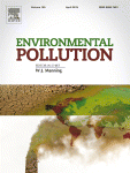Microplastics are taken up by mussels (Mytilus edulis) and lugworms (Arenicola marina) living in natural habitats
 Microplastic pollution is increasingly being considered as a threat to the marine environment in general and to small marine invertebrates at the base of the food chain in particlular As microplastics occur both in the seawater and in the sediment, we investigated the potential for microplastic ingestion in two organisms inhabiting these environments: the blue mussel (Mytilus edulis) and the lugworm (Arenicola marina). As a follow-up to our previously published research, the microplastic load in field-collected organisms - i.e. exposed to ambient microplastic concentrations - was assessed. In all collected specimens, we detected low concentrations of microplastics in both species, although the sediment dwelling lugworms contained somewhat higher concentrations. Subsequently, potential impacts of microplastic uptake of these species were assessed. Although some responses were measured, we detected no significant adverse effects of microplastic ingestion.
Microplastic pollution is increasingly being considered as a threat to the marine environment in general and to small marine invertebrates at the base of the food chain in particlular As microplastics occur both in the seawater and in the sediment, we investigated the potential for microplastic ingestion in two organisms inhabiting these environments: the blue mussel (Mytilus edulis) and the lugworm (Arenicola marina). As a follow-up to our previously published research, the microplastic load in field-collected organisms - i.e. exposed to ambient microplastic concentrations - was assessed. In all collected specimens, we detected low concentrations of microplastics in both species, although the sediment dwelling lugworms contained somewhat higher concentrations. Subsequently, potential impacts of microplastic uptake of these species were assessed. Although some responses were measured, we detected no significant adverse effects of microplastic ingestion.
Scientific abstract
We studied the uptake of microplastics under field conditions. At six locations along the French–Belgian–Dutch coastline we collected two species of marine invertebrates representing different feeding strategies: the blue mussel Mytilus edulis (filter feeder) and the lugworm Arenicola marina (deposit feeder). Additional laboratory experiments were performed to assess possible (adverse) effects of ingestion and translocation of microplastics on the energy metabolism (cellular energy allocation) of these species. Microplastics were present in all organisms collected in the field: on average 0.2 ± 0.3 microplastics g−1 (M. edulis) and 1.2 ± 2.8 particles g−1 (A. marina). In a proof of principle laboratory experiment, mussels and lugworms exposed to high concentrations of polystyrene microspheres (110 particles mL−1 seawater and 110 particles g−1 sediment, respectively) showed no significant adverse effect on the organisms' overall energy budget. The results are discussed in the context of possible risks as a result of the possible transfer of adsorbed contaminants.
Full reference (link)
Van Cauwenberghe, L., Claessens, M., Vandegehuchte, M.B., Janssen, C.R., 2015. Microplastics are taken up by mussels (Mytilus edulis) and lugworms (Arenicola marina) living in natural habitats. Environmental Pollution 199, 10-17.
